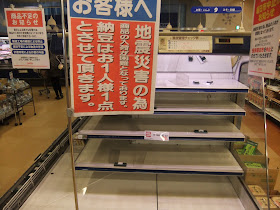After seeing so many traumatic photos and videos, and after reading so many heart-breaking articles on the apocalyptic devastation of Northern Japan by the triple quake-tsunami-nuclear disaster, it is quite understandable that many people should get haunted by this question.
My answer is clear and simple: "You will see Japan rise again, surprisingly FAST."
Let me explain the reasons.
First, the Japanese mentality.
Throughout the whole history of Japan, ever since the old-stone-age days that preceded the Jomon Period (ca.13,000 B.C. - ca.300B.C.) when early Japanese civilization started and developed, our ancestors have kept on rising from ruins caused by varieties of natural disasters: volcanic eruptions, earthquakes, tsunami, typhoons, floods, landslides...
Japan has been a nice archipelago to live in, blessed with temperate climate, rich vegetation thanks to plenty of rainfalls, secluded by the seas from invaders. Indeed very nice place to live in, except when its mother nature decided to whip her inhabitants with her overwhelming force for reasons unknown. And whatever her intention, the Japanese ancestors have developed their mentality to tolerate occasional natural blows as part of way of life, with resignation.
This resignation, whatever-will-come-will-come philosophy, however, is far from pessimism, despair, or apathy. On the contrary, it reinforces their spirit of solidarity and mutual help, deepens their empathy for the unfortunate, and enhances their collective will and energy to restore their normal life.
Accepting the reality of destruction, helping each other, mourning for the dead, then standing up for reconstruction with all the might, wisdom, and cooperation of the nation... this process is in the bones and blood of each Japanese. For a Japanese the question "Do you think Japan will rise again?" sounds foolish because coming back to normal life level even with some additional improvements is the way it should be for the Japanese. The Japanese do not tolerate any resignation or compromise in this aspect. That is Japanese mentality.
Second, as a whole, the majority of production facilities to supply the daily necessities to the Japanese are intact.
When World War II ended, almost all the Japanese cities were nothing but piles of ashes and debris, with few industries left. Many did not have even roofs under which to sleep, nor money to buy scarce food supply in the black market. Nevertheless, the Japanese rose from the ruins as the world witnessed. If there happens to be a younger-generation Japanese who whines over the hardship awaiting him, he will be laughed at by those who rebuilt Japan from the wreckage of the war.
In the media coverage, we see refugees lacking water, blankets, gas, and food. This is largely due to the rupture of lifelines in the devastated areas, to the confusion and lack of manpower of administration, and to the fact that affected regions are widespread. There are sufficient supplies in other parts of Japan. With passage of time, I am convinced, the situation will keep on improving.
Finally, there are many friendly nations and individuals who are eager to help Japan.
Although it is Japan itself who has to help itself, the message from overseas to tell the Japanese that they are not alone is reassuring and encouraging. As one Japanese, I would like to express my deepest gratitude to the people doing something to help Japan. Surrounded by great numbers of friendly and helpful nations and people, I do not see any reason why Japan will not rise again this time also.









































